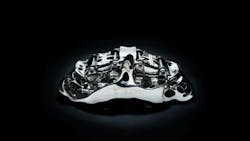Bugatti uses SLM Solutions additive manufacturing systems in component production
Sports car maker Bugatti (Molsheim, France) used SLM Solutions' (Lübeck, Germany) metal additive manufacturing technology to produce automotive components. The components were manufactured in the aerospace alloy Ti6Al4V in cooperation with the Fraunhofer Research Institution for Additive Manufacturing Technologies (Fraunhofer IAPT; Hamburg, Germany) and Bionic Production (Lüneburg, Germany) on a SLM 500 selective laser melting system featuring four 400 W lasers.
A caliper test showed that additively produced metal components can cope with extreme strength, stiffness, and temperature requirements at speeds of over 375 km/h with a braking force of 1.35 g and brake disc temperatures up to 1100°C, says Frank Götzke, Head of New Technologies at Bugatti. The test also showed that a tensile strength of 1250 N/mm2 and a material density over 99.7% was achieved.
Testing the 3D-printed brake caliper from Bugatti. (Copyright: SLM Solutions Group AG)
Bugatti utilizes selective laser melting not only for lightweighting, but also within the functional scope of its vehicles. An active spoiler bracket, manufactured on a SLM 500 with Fraunhofer IAPT, represents this combination, aiding the 1500 hp vehicle to reach speeds of 400 km/h in 32.6 seconds and bringing it back to a stop in 9 seconds. The active rear spoiler can be adjusted in height and angle, supporting the sophisticated aerodynamics required.
Bugatti teamed with Siemens (Munich, Germany) to optimize the bracket for production and reduce the number of iterations needed to optimize for weight and rigidity. Using 3D-printed titanium with a tensile strength of 1250 MPa and a material density of over 99.7%, the spoiler bracket was reduced by 5.4 kg, a weight reduction of 53%, yet increased rigidity while sacrificing no functional benefits.
Related: SLM Solutions signs long-term cooperation agreement, gains multi-machine order
With fewer sparks, a small bracket with integrated water cooling acts an active heat shield to dramatically reduce transferred heat. The motor bracket has been installed in all series vehicles since the delivery of the first Bugatti Chiron from the company's production facility in Molsheim.
Built on the SLM 500, this Bugatti brake caliper is the volumetrically largest functional titanium component in the world. (Copyright: SLM Solutions Group AG)
The Chiron, like its predecessor, the Veyron, has two separate water-cooling circuits to keep the component and system temperatures at an acceptable level, even under the most extreme environmental and operating conditions. The high-temperature circuit is used to cool the 1500 hp W16 engine of the car, while the low-temperature circuit ensures that the intake charge cooling temperature remains suitably low. A bypass flow filter of the NT circuit supplies the console while isolating the electronic components from the temperatures of the transmission oil tank. The primary task of the bracket is to engage the gears while opening and closing the two clutches of the 7-speed dual-clutch transmission while including the control unit. As a result, the temperature at the electric motor and at the control unit of the pump when driving through a demanding handling course can be lowered from 130° to 90°C, a reduction of 40°C.
The bracket, which was manufactured in the alloy AlSi10Mg on a SLM 280 Twin laser system, was commissioned by SLM Solutions at Rolf Lenk Werkzeugbau (Ahrensburg, Germany).
At the Formnext 2018 trade fair held November 13-16 in Frankfurt, Germany, the SLM Solutions booth featured eight Bugatti W16 cylinder head covers as production studies, which were created in a single construction job on an SLM 800 system, with each hood measuring 285 mm wide, 65 mm thick, and 735 mm tall.


